
Analyse de la marque CONOR
From the end of the 4th century the marks COMOB, CONOB appear on gold coins. OB meant Obryzum and therefore read: ''pure gold''. We also find the mark CORMOB, but all marks always end with OB. Always? No. There is a CONOR mark. At present, the numismatic community considers the presence of the letter R as a badly executed B or as a mistake. I come to show that it is a will and to try to explain this choice.
First of all, this mark is visible on many coins: for Zeno, RIC #910, 911 (911 variant without jewells on the diadem) 929 and 930 (930 same peculiarity as for the 911). I analyzed 1,000 coins, on this corpus I found more than 100 copies where the CONOR mark is indisputable. We will see later why I specify ''indisputable''. Of course, these 1,000 coins contain duplicates, but the ratio of 1/10 ° is still sufficient to demonstrate that this is not an error. Here is a coin showing this mark with a letter R called ''indisputable'':
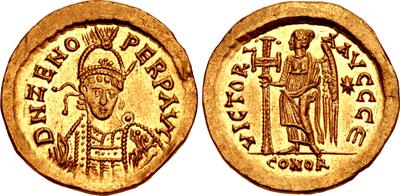
Photo of a solidus sold the 13/09/2017 by Classical Numismatic Group, Auction 106, lot 862, link to the sale: https://www.acsearch.info/search.html?id=4339382, link to their website: https://www.cngcoins.com/.
Another problematic needs to be raised. For Zeno, the CONOR mark have been corrected by CONOB! At the moment I have only found this ''correction'' for Zeno coins. I have not yet studied other emperors to see if this peculiarity exists elsewhere. Many CONOB marks display a letter R to which has been added a line at the bottom to form a letter B. We can clearly see that this is not a bad execution of the engraving. Firstly because this correction is seen on too many different coins, solididi, tremissi ... but also different dies and probably made by different engravers. I must add here that many coins have the letter B in the shape of R because the bottom is cut by the beadings. Engraving error? The last letter arriving too close to the edge and therefore not being able to be complete? In some cases maybe, but in many others the letter R is far from the edge and leaves no doubt. Let's see here three solidi where the letter R is corrected:
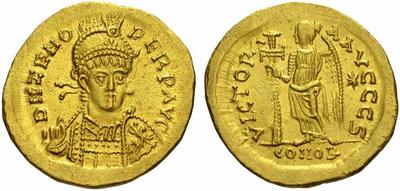
Photo of a coin sold the 12/05/2004 by Numismatica Ars Classica, Auction 27, lot 540, link to the sale: https://www.acsearch.info/search.html?id=171010, link to their website: https://www.arsclassicacoins.com/.
This coin shows a line under the leg of the letter R that does not join the end. Another coin below, with a thin line in the same place:
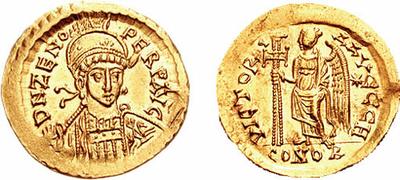
Photo of a coin sold the 08/06/2005 by Classical Numismatic Group, Mail Bid Sale 69, lot 1799, link to the sale: https://www.acsearch.info/search.html?id=235504, link to their website: https://www.cngcoins.com/.
Finally, a third coin with the same little line:
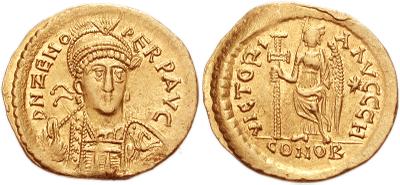
Photo of a coin sold the 31/01/2007 by Classical Numismatic Group, Electronic Auction 157, lot 357, link to the sale: https://www.acsearch.info/search.html?id=355459, link to their website: https://www.cngcoins.com/.
We can even group together coins where the letter B is oddly shaped, probably a more awkward correction. The solidus below shows a Delta in the shape of a B:
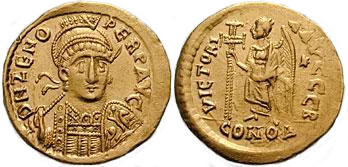
Photo of a coin sold the 04/04/2001 by Classical Numismatic Group, Mail Bid Sale 57, lot 1450, link to the sale: https://www.acsearch.info/search.html?id=81408, link to their website: https://www.cngcoins.com/.*
To better identify corrected marks, we must remove the lower part of this letter B and see if the shape perfectly evokes a letter R. We must also see if the leg of the letter R ends in a wider triangular point. Showing that the engraver had finished one extremity. This is a detail that we always find on all letters.
What definitely demonstrates that the corrections are real and that it was not a clumsy engraving is the presence of two coins sharing the same dies. The first coin with the mark CONOR and the second coin having CONOB resulting from a correction of the letter R by adding a thin line under the letter to form a B. The modification was made shortly after the striking of the copy with the mark CONOR. Both currencies have the same die breaks and these are not more pronounced on either of the two coins. Given the degree of wear on the reverse, the strike of CONOR was long before his correction. Here is the photo of the coin with the mark CONOR:
.jpg?1622107791247)
Photo of a coin sold the 11/06/2012 by Numismatik Lanz München, Auction 154, lot 619, link to the sale: https://www.acsearch.info/search.html?id=1311146, link to their website: https://www.lanz.com/.
Here is the second coin with the corrected mark:
.jpg?1622107856652)
Photo of a coin sold the 09/12/2017 by Jean Elsen & ses Fils S.A., Auction 135, lot 382, link to the sale: https://www.acsearch.info/search.html?id=4597412, link to their website: https://www.elsen.eu/.
Who corrected these errors? We think of a Roman in charge of supervising the mint. Yet we can doubt because of this coin:
.jpg?1623856069618)
Photo of a coin sold the 24/05/2016 by Numismatica Ars Classica, Auction 93, lot 1123, link to the sale: https://www.acsearch.info/search.html?id=3109862, link to their website: https://www.arsclassicacoins.com/.
This coin has the CONOR mark corrected in CONOB but the letter R of PERP on the obverse is also corrected in B ... What happened? We can think that the corrector has chosed the wrong place to correct, being distracted or perhaps not in his normal state. Or we can think that the corrector was also of German origin and corrected without understanding the meaning of the letters. We can not conclude anything with this single copy. Another coin sold the 29/10/2000 by Frank Sternberg AG, Auction 35, lot 944 seems to show the same peculiarity but the black and white photo and too small, does not allow to conclude to a correction rather than a die break. Link to the coin: https://www.acsearch.info/search.html?id=73883. We can also cite coins from the third and fifth issue, which show an officina letter B in a strange shape and probably the result of a letter R corrected to B. This copy is one of the best examples:
.jpg?1625730011470)
Photo of a coin sold the 08/10/2017 by Savoca Numismatik, 18th Silver Auction, lot 328, link to the sale: https://www.acsearch.info/search.html?id=4411709, link to their website: http://www.savoca-coins.com/.
At this stage it will therefore be necessary to explain the presence of this mark CONOR. Can we imagine that this is the origin of the word "or" (in french meaning ''gold''? These Zeno coins were struck by Visigoths and, as we will see later in the article, many other Germanic peoples produce coins with this same mark. Phenomenon of Rhotacism? Or a distortion of the Latin word avrvm? These proposals seem likely. Recall that the Visigoths were Latinized but this does not imply that their level of practice of the Latin language does not contain deformations or shortcuts. We still see it today when learning a language, when a misunderstanding of pronunciation occurs, it is very often the end of the word that is misunderstood. The erroneous oral transmission may have caused the word ''or''.
This mark is found from the 5th century until the 7th century. And this always seems to be in strikes carried out by German peoples. Visigoths, Ostrogohts, Lombars ... Let's see some examples:
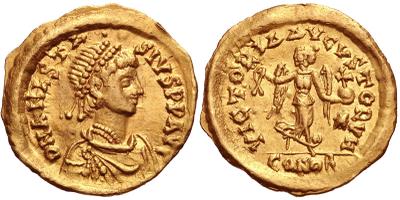
Photo of a Ostrogothic Tremissis of Theoderic in the name of Anastasius 491 - 518, sold the 16/11/2011 by Classical Numismatic Group, Electronic Auction 268, lot 477, link to the sale: https://www.acsearch.info/search.html?id=1138972, link to their website: https://www.cngcoins.com/.
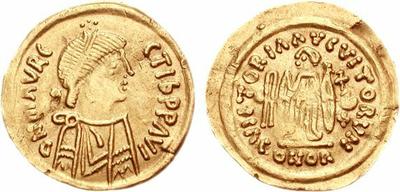
Photo of Tremissis from Lombards in the name of Mauricius Tiberius 568 - 616, sold the 16/09/2009 by Classical Numismatic Group, Mail Bid Sale 82, lot 1144, link to the sale: https://www.acsearch.info/search.html?id=656713, link to their website: https://www.cngcoins.com/.
Another Tremissis from Lombards, still in the name of Mauricius Tiberius 620 - 700:
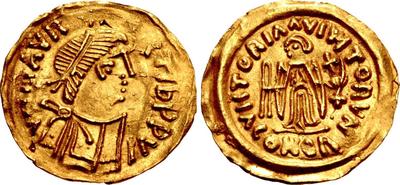
Photo of a coin sold the 14/01/2020 by Classical Numismatic Group, Triton XXIII, lot 1005, link to the sale: https://www.acsearch.info/search.html?id=6670378, link to their website: https://www.cngcoins.com/.
To finish let's add this Solidus of Justinian I, 542 - 565:
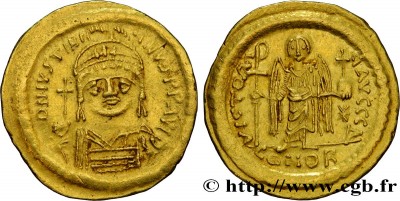
Photo of a coin sold the 01/03/2016 by CGB.fr, e-Monnaies Mars 2016, lot 381483, link to the sale: https://www.acsearch.info/search.html?id=3000835, link to their website: https://www.cgbfr.com/.
The question being, who engraved this Justinian I coin? Probably a person of Germanic origin.
In conclusion, there is an origin to this mark, which begins from the end of the 4th century and which corresponds to the great Gothic migrations. During their flight from the Huns and their assimilation into the Roman people. The fact that their strikes for the Romans present this mark and that it is also found in the Lombard ones no longer leaves any doubt as to the common core of this mark: the germans. We know little about their language and even less about their level of practice of the Latin language. We could even estimate, given their importance in the Roman people at various times, that they perhaps marked the coins of their imprint, noting OR, term which spoke to them. A Roman in charge of the mint, sometimes correcting the dies to match what the Empire expected. Only, the probable correction of the officina letter B on some copies questions the understanding of the letter B by the Visigoths. Was there a problem with that letter or was the word ''or'' part of their language?